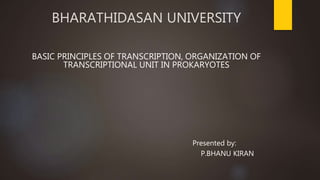Basic principle of transcription, organization of transcriptional units in prokaryotes
•Transferir como PPTX, PDF•
7 gostaram•2,129 visualizações
Basic Knowledge
Denunciar
Compartilhar
Denunciar
Compartilhar

Recomendados
Recomendados
Mais conteúdo relacionado
Mais procurados
Mais procurados (20)
Semelhante a Basic principle of transcription, organization of transcriptional units in prokaryotes
Semelhante a Basic principle of transcription, organization of transcriptional units in prokaryotes (20)
DNA transcription & Post Transcriptional Modification

DNA transcription & Post Transcriptional Modification
Replication, transcription, translation and its regulation

Replication, transcription, translation and its regulation
transcription in prokaryotes and RNA polymerase of prokaryotes

transcription in prokaryotes and RNA polymerase of prokaryotes
TRANSCRIPTION & POST-TRANSCRIPTIONAL MODIFICATIONS

TRANSCRIPTION & POST-TRANSCRIPTIONAL MODIFICATIONS
Último
God is a creative God Gen 1:1. All that He created was “good”, could also be translated “beautiful”. God created man in His own image Gen 1:27. Maths helps us discover the beauty that God has created in His world and, in turn, create beautiful designs to serve and enrich the lives of others.
Explore beautiful and ugly buildings. Mathematics helps us create beautiful d...

Explore beautiful and ugly buildings. Mathematics helps us create beautiful d...christianmathematics
Último (20)
Python Notes for mca i year students osmania university.docx

Python Notes for mca i year students osmania university.docx
Measures of Dispersion and Variability: Range, QD, AD and SD

Measures of Dispersion and Variability: Range, QD, AD and SD
Explore beautiful and ugly buildings. Mathematics helps us create beautiful d...

Explore beautiful and ugly buildings. Mathematics helps us create beautiful d...
Energy Resources. ( B. Pharmacy, 1st Year, Sem-II) Natural Resources

Energy Resources. ( B. Pharmacy, 1st Year, Sem-II) Natural Resources
Web & Social Media Analytics Previous Year Question Paper.pdf

Web & Social Media Analytics Previous Year Question Paper.pdf
ICT Role in 21st Century Education & its Challenges.pptx

ICT Role in 21st Century Education & its Challenges.pptx
Z Score,T Score, Percential Rank and Box Plot Graph

Z Score,T Score, Percential Rank and Box Plot Graph
Seal of Good Local Governance (SGLG) 2024Final.pptx

Seal of Good Local Governance (SGLG) 2024Final.pptx
Basic principle of transcription, organization of transcriptional units in prokaryotes
- 1. BHARATHIDASAN UNIVERSITY BASIC PRINCIPLES OF TRANSCRIPTION, ORGANIZATION OF TRANSCRIPTIONAL UNIT IN PROKARYOTES Presented by: P.BHANU KIRAN
- 2. CONTENT Introduction Basic principle of transcription Organization of transcriptional unit in prokaryotes Promoters RNA coding sequence Termination Reference
- 3. INTRODUCTION Transcription is the first step in gene expression. It involves copying a gene's DNA sequence to make an RNA molecule. Transcription is performed by enzymes called RNA polymerases, which link nucleotides to form an RNA strand (using a DNA strand as a template). Transcription has three stages: initiation, elongation, and termination. In eukaryotes, RNA molecules must be processed after transcription: they are spliced and have a 5' cap and poly-A tail put on their ends. Transcription is controlled separately for each gene in your genome.
- 4. BASIC PRINCIPLE OF TRANSCRIPTION RNA is the intermediate between gene and the proteins for which they code. Transcription is the synthesis of RNA under the direction of DNA . Transcription produces messenger RNA (mRNA) . In prokaryotes, mRNA produced by transcription is immediately translated without more processing. In eukaryotes, the nuclear envelope separates transcription from translation. Eukaryotic RNA transcripts are modified through RNA processing to yield finished mRNA. A primary transcript is the initial RNA transcript from any gene. Eukaryotic RNA transcripts are modified through RNA processing to yield finished mRNA.
- 7. ORGANIZATION OF TRANSCRIPTIONAL UNIT IN PROKARYOTES There are basically three transcriptional units in prokaryotic organisms and which are as follows: 1. Promoters 2. RNA coding sequence 3. Terminator
- 8. Promoters A promoter is a regulatory region of DNA located upstream (towards the 5' region) of a gene, providing a control point for regulated gene transcription. The promoter contains specific DNA sequences that are recognized by proteins known as transcription factors. These factors bind to the promoter sequences, recruiting RNA polymerase, the enzyme that synthesizes the RNA from the coding region of the gene. Prokaryotic promoters In prokaryotes, the promoter consists of two short sequences at -10 and -35 positions upstream from the transcription start site. The sequence at -10 is called the Pribnow box, or the -10 element, and usually consists of the six nucleotides TATAAT. The Pribnow box is absolutely essential to start transcription in prokaryotes. The other sequence at -35 (the -35 element) usually consists of the six nucleotides TTGACA. Its presence allows a very high transcription rate.
- 10. RNA coding sequence DNA is the RNA coding sequence and along with promoter region the RNA polymerase carries on the activity of producing mRNA.
- 11. Termination There are two major termination strategies found in bacteria: Rho- dependent and Rho-independent. In Rho-dependent termination, the RNA contains a binding site for a protein called Rho factor. Rho factor binds to this sequence and starts "climbing" up the transcript towards RNA polymerase. When it catches up with the polymerase at the transcription bubble, Rho pulls the RNA transcript and the template DNA strand apart, releasing the RNA molecule and ending transcription. Another sequence found later in the DNA, called the transcription stop point, causes RNA polymerase to pause and thus helps Rho catch up.
- 13. Rho-independent termination depends on specific sequences in the DNA template strand. As the RNA polymerase approaches the end of the gene being transcribed, it hits a region rich in C and G nucleotides. The RNA transcribed from this region folds back on itself, and the complementary C and G nucleotides bind together. The result is a stable hairpin that causes the polymerase to stall. In a terminator, the hairpin is followed by a stretch of U nucleotides in the RNA, which match up with A nucleotides in the template DNA. The complementary U-A region of the RNA transcript forms only a weak interaction with the template DNA. This, coupled with the stalled polymerase, produces enough instability for the enzyme to fall off and liberate the new RNA transcript.